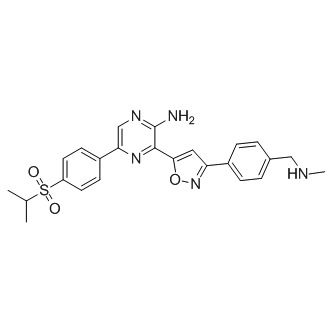| Cas No.: | 1232416-25-9 |
| Chemical Name: | 2-Pyrazinamine, 3-[3-[4-[(methylamino)methyl]phenyl]-5-isoxazolyl]-5-[4-[(1-methylethyl)sulfonyl]phenyl]- |
| Synonyms: | VE822; VE 822 |
| SMILES: | CC(C)S(=O)(=O)C1=CC=C(C=C1)C2=CN=C(C(=N2)C3=CC(=NO3)C4=CC=C(C=C4)CNC)N |
| Formula: | C24H25N5O3S |
| M.Wt: | 463.55 |
| Purity: | >98% |
| Sotrage: | 2 years -20°C Powder, 2 weeks 4°C in DMSO, 6 months -80°C in DMSO |
| Description: | Berzosertib (VE-822) is an ATR inhibitor with a Ki value of less than 0.2 nM. It also inhibits ATM with a Ki of 34 nM. |
| In Vivo: | PSN-1 xenografts are treated with Berzosertib (VE-822) (60 mk/kg; d0, 1), Gemcitabine (100 mg/kg; d0) and/or XRT (6 Gy; d1). Tumors are then harvested 2 h post-XRT. Berzosertib (VE-822) inhibits p-Ser-345-Chk1 in xenografts after DNA-damaging agents, establishing VE-822 as a potent inhibitor of ATR in vivo. Besides, Berzosertib (VE-822) enhances the therapeutic efficacy of radiation (XRT) in MiaPaCa-2 and PSN-1 xenograft models[1]. |
| In Vitro: | Berzosertib (VE-822) also inhibits DNK-PA, mTOR, PI3Kγ with IC50 of >4, >1, and 0.22 μM, respectively. In PSN-1 and MiaPaCa-2 cells, Berzosertib (VE-822) inhibits ATR and ATM with IC50 of 19 nM and 2.6 μM, respectively. VE-822 (80 nM) reduces phospho-Ser345-Chk1 after Gemcitabine (100 nM), radiation (XRT) (6 Gy) or both in PDAC. Additionally, Berzosertib (VE-822) does not inhibit ATM, Chk2 or DNA-PK phosphorylation in response to radiation, which further supports the selectivity of Berzosertib (VE-822) for ATR. VE-822 decreases survival of irradiated PDAC (all lines used are p53-mutant; K-Ras mutant). Knock down of Chk1 by siRNA sensitizes PSN-1 and MiaPaCa-2 cells to radiation but the radiosensitising effect is less profound compare with Berzosertib (VE-822). Adding Berzosertib (VE-822) to Gemcitabine reduces survival ~2-3-fold and dramatically more after chemoradiotherapy[1]. |

 To enhance service speed and avoid tariff delays, we've opened a US warehouse. All US orders ship directly from our US facility.
To enhance service speed and avoid tariff delays, we've opened a US warehouse. All US orders ship directly from our US facility.




















